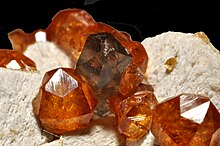
Amethyst is a lilac variety of quartz. The name comes from the Koine Greek αμέθυστος amethystos from α- a-, "not" and μεθύσκω methysko / μεθώ metho, "intoxicate", a reference to the belief that the stone protected its owner from drunkenness. Ancient Greeks wore amethyst and carved drinking vessels from it in the belief that it would prevent intoxication.

Amblygonite is a fluorophosphate mineral, (Li,Na)AlPO4(F,OH), composed of lithium, sodium, aluminium, phosphate, fluoride and hydroxide. The mineral occurs in pegmatite deposits and is easily mistaken for albite and other feldspars. Its density, cleavage and flame test for lithium are diagnostic. Amblygonite forms a series with montebrasite, the low fluorine endmember. Geologic occurrence is in granite pegmatites, high-temperature tin veins, and greisens. Amblygonite occurs with spodumene, apatite, lepidolite, tourmaline, and other lithium-bearing minerals in pegmatite veins. It contains about 10% lithium, and has been utilized as a source of lithium. The chief commercial sources have historically been the deposits of California and France.
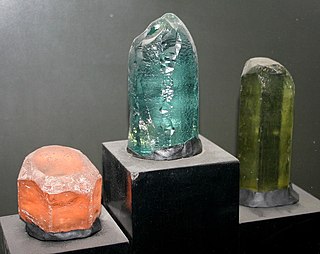
Beryl ( BERR-əl) is a mineral composed of beryllium aluminium silicate with the chemical formula Be3Al2Si6O18. Well-known varieties of beryl include emerald and aquamarine. Naturally occurring, hexagonal crystals of beryl can be up to several meters in size, but terminated crystals are relatively rare. Pure beryl is colorless, but it is frequently tinted by impurities; possible colors are green, blue, yellow, pink, and red (the rarest). It is an ore source of beryllium.

Sapphire is a precious gemstone, a variety of the mineral corundum, consisting of aluminium oxide (α-Al2O3) with trace amounts of elements such as iron, titanium, chromium, vanadium, or magnesium. The name sapphire is derived via the Latin "sapphirus" from the Greek "sappheiros", which referred to lapis lazuli. It is typically blue, but natural "fancy" sapphires also occur in yellow, purple, orange, and green colors; "parti sapphires" show two or more colors. Red corundum stones also occur, but are called rubies rather than sapphires. Pink-colored corundum may be classified either as ruby or sapphire depending on locale. Commonly, natural sapphires are cut and polished into gemstones and worn in jewelry. They also may be created synthetically in laboratories for industrial or decorative purposes in large crystal boules. Because of the remarkable hardness of sapphires – 9 on the Mohs scale (the third hardest mineral, after diamond at 10 and moissanite at 9.5) – sapphires are also used in some non-ornamental applications, such as infrared optical components, high-durability windows, wristwatch crystals and movement bearings, and very thin electronic wafers, which are used as the insulating substrates of special-purpose solid-state electronics such as integrated circuits and GaN-based blue LEDs. Sapphire is the birthstone for September and the gem of the 45th anniversary. A sapphire jubilee occurs after 65 years.
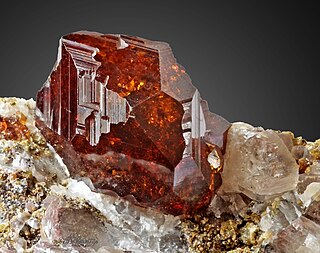
Garnets are a group of silicate minerals that have been used since the Bronze Age as gemstones and abrasives.

Peridot, sometimes called chrysolite, is a deep yellowish-green transparent variety of olivine. Peridot is one of the few gemstones that occurs in only one color.

The mineral or gemstone chrysoberyl is an aluminate of beryllium with the formula BeAl2O4. The name chrysoberyl is derived from the Greek words χρυσός chrysos and βήρυλλος beryllos, meaning "a gold-white spar". Despite the similarity of their names, chrysoberyl and beryl are two completely different gemstones, although they both contain beryllium. Chrysoberyl is the third-hardest frequently encountered natural gemstone and lies at 8.5 on the Mohs scale of mineral hardness, between corundum (9) and topaz (8).

Benitoite is a rare blue barium titanium cyclosilicate, found in hydrothermally altered serpentinite. It forms in low temperature, high pressure environments typical of subduction zones at convergent plate boundaries. Benitoite fluoresces under short wave ultraviolet light, appearing bright blue to bluish white in color. The more rarely seen clear to white benitoite crystals fluoresce red under long-wave UV light.

Cordierite (mineralogy) or iolite (gemology) is a magnesium iron aluminium cyclosilicate. Iron is almost always present and a solid solution exists between Mg-rich cordierite and Fe-rich sekaninaite with a series formula: (Mg,Fe)2Al3(Si5AlO18) to (Fe,Mg)2Al3(Si5AlO18). A high-temperature polymorph exists, indialite, which is isostructural with beryl and has a random distribution of Al in the (Si,Al)6O18 rings.

Almandine, also known as almandite, is a species of mineral belonging to the garnet group. The name is a corruption of alabandicus, which is the name applied by Pliny the Elder to a stone found or worked at Alabanda, a town in Caria in Asia Minor. Almandine is an iron alumina garnet, of deep red color, inclining to purple. It is frequently cut with a convex face, or en cabochon, and is then known as carbuncle. Viewed through the spectroscope in a strong light, it generally shows three characteristic absorption bands.

Pezzottaite, marketed under the name raspberyl or raspberry beryl, is a mineral species first recognized by the International Mineralogical Association in September 2003. Pezzottaite is a caesium analogue of beryl, a silicate of caesium, beryllium, lithium and aluminium, with the chemical formula Cs(Be2Li)Al2Si6O18. Named after Italian geologist and mineralogist Federico Pezzotta, pezzottaite was first thought to be either red beryl or a new variety of beryl ("caesium beryl"); unlike actual beryl, however, pezzottaite contains lithium and crystallizes in the trigonal crystal system rather than the hexagonal system.

Demantoid is the green gemstone variety of the mineral andradite, a member of the garnet group of Minerals. Andradite is a calcium- and iron-rich garnet. The chemical formula is Ca3Fe2(SiO4)3 with chromium substitution as the cause of the demantoid green color. Ferric iron is the cause of the yellow in the stone.
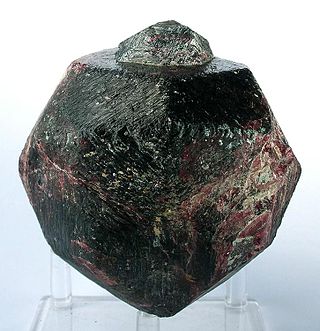
The mineral pyrope is a member of the garnet group. Pyrope is the only member of the garnet family to always display red colouration in natural samples, and it is from this characteristic that it gets its name: from the Greek for fire and eye. Despite being less common than most garnets, it is a widely used gemstone with numerous alternative names, some of which are misnomers. Chrome pyrope, and Bohemian garnet are two alternative names, the usage of the latter being discouraged by the Gemological Institute of America. Misnomers include Colorado ruby, Arizona ruby, California ruby, Rocky Mountain ruby, Elie Ruby, Bohemian carbuncle, and Cape ruby.

Grossular is a calcium-aluminium species of the garnet group of minerals. It has the chemical formula of Ca3Al2(SiO4)3 but the calcium may, in part, be replaced by ferrous iron and the aluminium by ferric iron. The name grossular is derived from the botanical name for the gooseberry, grossularia, in reference to the green garnet of this composition that is found in Siberia. Other shades include cinnamon brown (cinnamon stone variety), red, and yellow. Grossular is a gemstone.
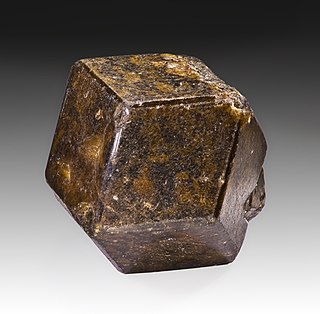
Andradite is a mineral species of the garnet group. It is a nesosilicate, with formula Ca3Fe2Si3O12.
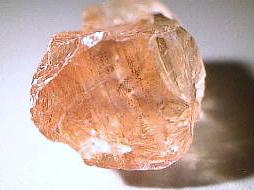
Sunstone is a microcline or oligoclase feldspar, which when viewed from certain directions exhibits a spangled appearance. It has been found in Southern Norway, Sweden, various United States localities and on some beaches along the midcoast of South Australia.
Malaia garnet or Malaya garnet is a gemological varietal name for light to dark slightly pinkish orange, reddish orange, or yellowish orange garnet, that are of a mixture within the pyralspite series pyrope, almandine, and spessartine with a little calcium. The name Malaia is translated from Swahili to mean, prostitute. It is found in east Africa, in the Umba Valley bordering Tanzania and Kenya.

Neptunite is a silicate mineral with the formula KNa2Li(Fe2+, Mn2+)2Ti2Si8O24. With increasing manganese it forms a series with mangan-neptunite. Watatsumiite is the variety with vanadium replacing the titanium in the formula.
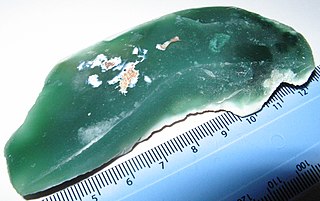
Chrome chalcedony is a green variety of the mineral chalcedony, colored by small quantities of chromium. It is most commonly found in Zimbabwe, where it is known as Mtorolite, Mtorodite, or Matorolite.
John Sinkankas was a Navy officer and aviator, gemologist, gem carver and gem faceter, author of many books and articles on minerals and gemstones, and a bookseller and bibliographer of rare books.
